HI6006: Carlsberg's Corporate Strategy in Emerging Markets
VerifiedAdded on 2022/10/19
|17
|3388
|204
Report
AI Summary
This report provides a comprehensive case study analysis of Carlsberg's corporate strategy, particularly focusing on its expansion into emerging markets. The analysis begins with an executive summary and table of contents, followed by an introduction that emphasizes the importance of organizational strategies in competitive markets. The report details Carlsberg's expansion, strategic issues in Russia and China, and relevant theoretical concepts like strategic entrepreneurship. It applies SWOT analysis, Porter's Five Forces, and the VRIO framework to assess the company's micro-environment and internal resources. Furthermore, it includes the application of a business-level strategy formulation model, and concludes with a summary of findings and references.
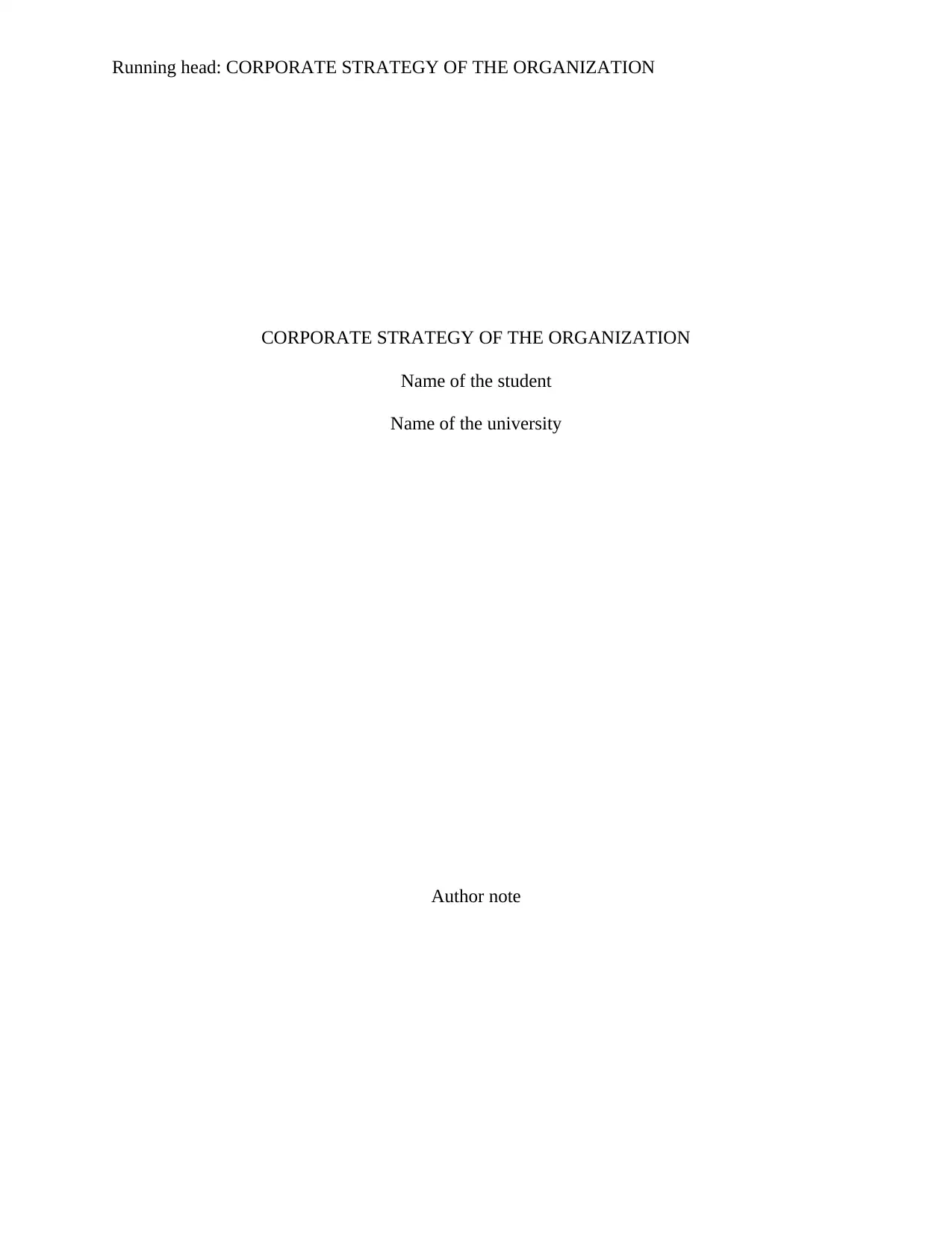
Running head: CORPORATE STRATEGY OF THE ORGANIZATION
CORPORATE STRATEGY OF THE ORGANIZATION
Name of the student
Name of the university
Author note
CORPORATE STRATEGY OF THE ORGANIZATION
Name of the student
Name of the university
Author note
Paraphrase This Document
Need a fresh take? Get an instant paraphrase of this document with our AI Paraphraser
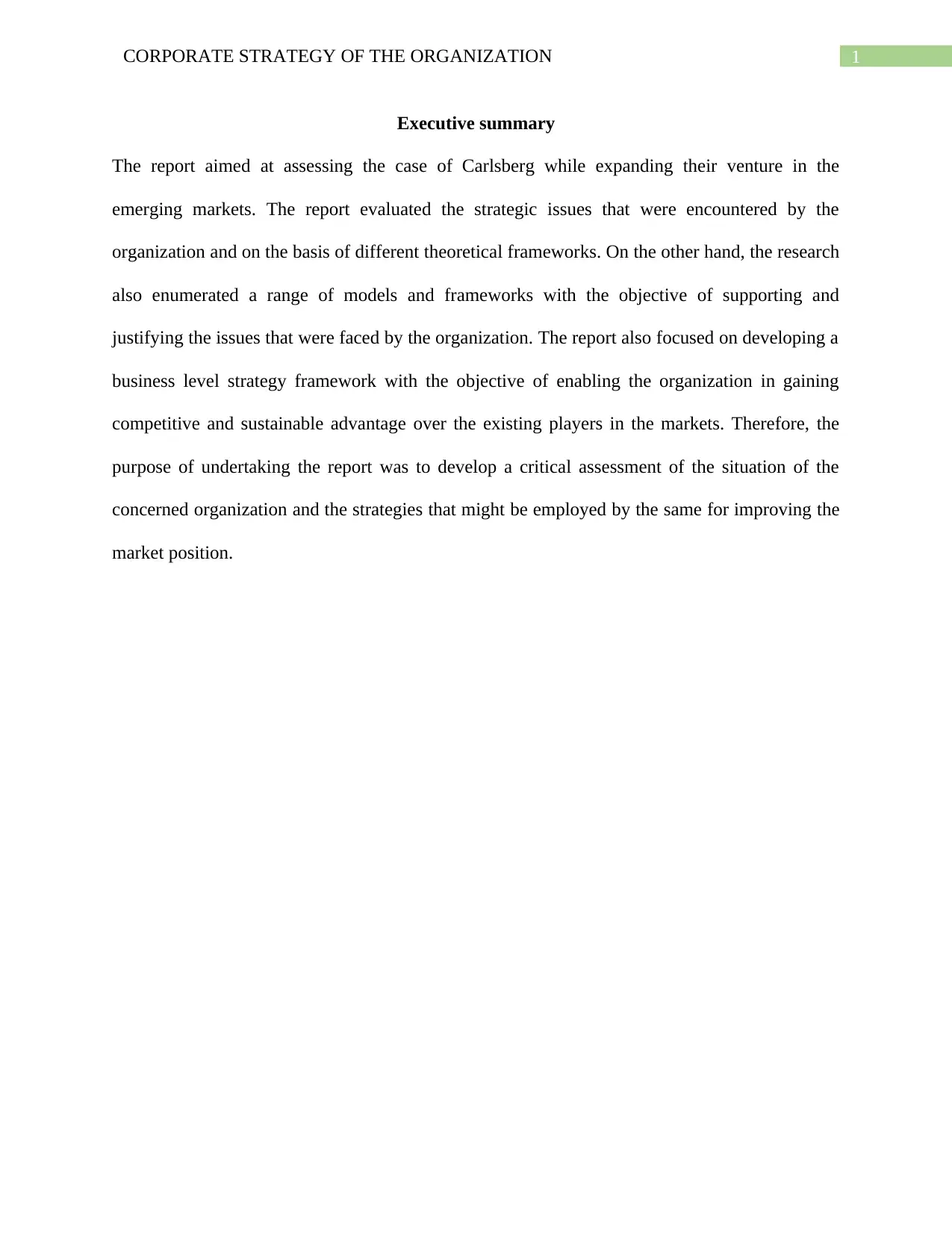
1CORPORATE STRATEGY OF THE ORGANIZATION
Executive summary
The report aimed at assessing the case of Carlsberg while expanding their venture in the
emerging markets. The report evaluated the strategic issues that were encountered by the
organization and on the basis of different theoretical frameworks. On the other hand, the research
also enumerated a range of models and frameworks with the objective of supporting and
justifying the issues that were faced by the organization. The report also focused on developing a
business level strategy framework with the objective of enabling the organization in gaining
competitive and sustainable advantage over the existing players in the markets. Therefore, the
purpose of undertaking the report was to develop a critical assessment of the situation of the
concerned organization and the strategies that might be employed by the same for improving the
market position.
Executive summary
The report aimed at assessing the case of Carlsberg while expanding their venture in the
emerging markets. The report evaluated the strategic issues that were encountered by the
organization and on the basis of different theoretical frameworks. On the other hand, the research
also enumerated a range of models and frameworks with the objective of supporting and
justifying the issues that were faced by the organization. The report also focused on developing a
business level strategy framework with the objective of enabling the organization in gaining
competitive and sustainable advantage over the existing players in the markets. Therefore, the
purpose of undertaking the report was to develop a critical assessment of the situation of the
concerned organization and the strategies that might be employed by the same for improving the
market position.
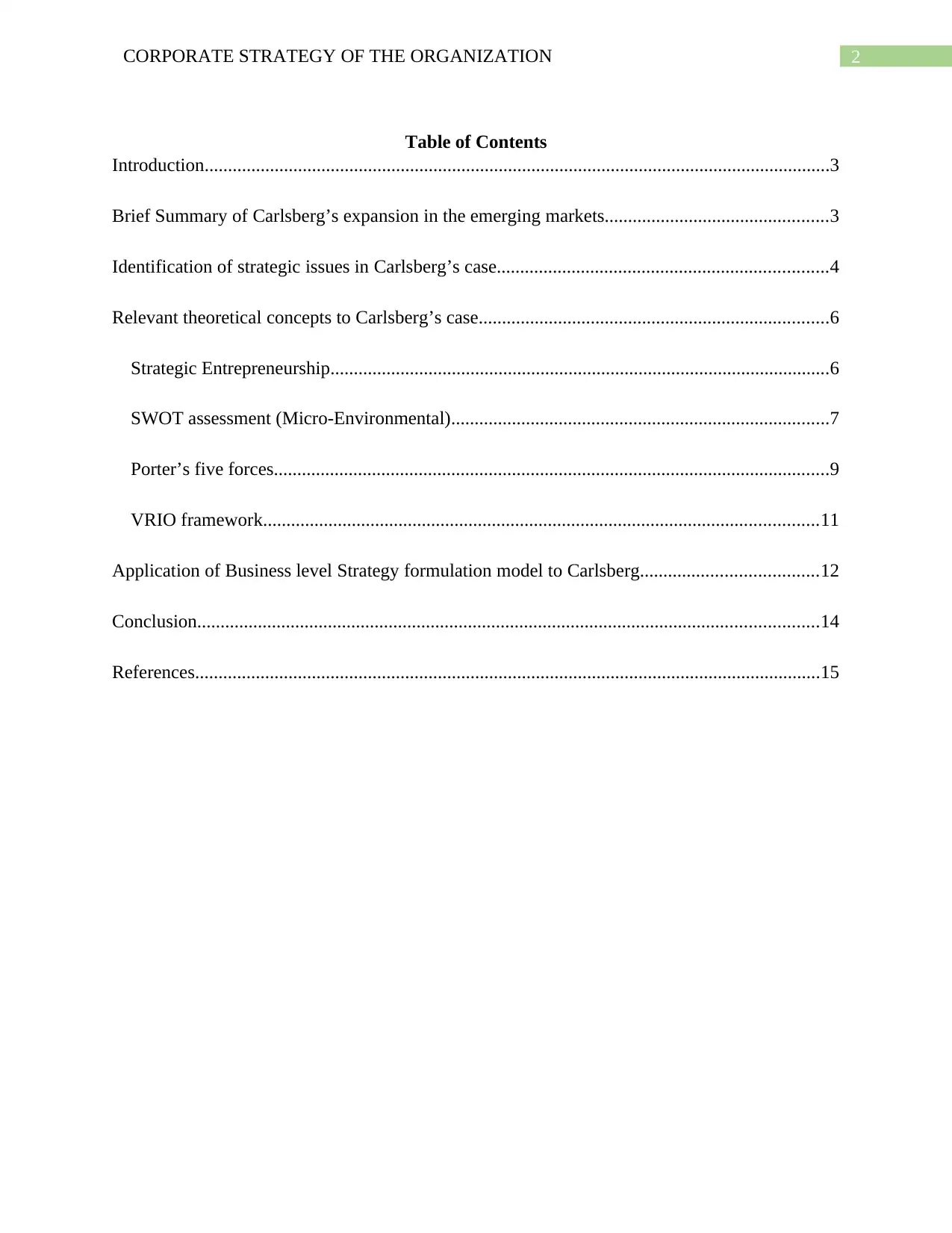
2CORPORATE STRATEGY OF THE ORGANIZATION
Table of Contents
Introduction......................................................................................................................................3
Brief Summary of Carlsberg’s expansion in the emerging markets................................................3
Identification of strategic issues in Carlsberg’s case.......................................................................4
Relevant theoretical concepts to Carlsberg’s case...........................................................................6
Strategic Entrepreneurship...........................................................................................................6
SWOT assessment (Micro-Environmental).................................................................................7
Porter’s five forces.......................................................................................................................9
VRIO framework.......................................................................................................................11
Application of Business level Strategy formulation model to Carlsberg......................................12
Conclusion.....................................................................................................................................14
References......................................................................................................................................15
Table of Contents
Introduction......................................................................................................................................3
Brief Summary of Carlsberg’s expansion in the emerging markets................................................3
Identification of strategic issues in Carlsberg’s case.......................................................................4
Relevant theoretical concepts to Carlsberg’s case...........................................................................6
Strategic Entrepreneurship...........................................................................................................6
SWOT assessment (Micro-Environmental).................................................................................7
Porter’s five forces.......................................................................................................................9
VRIO framework.......................................................................................................................11
Application of Business level Strategy formulation model to Carlsberg......................................12
Conclusion.....................................................................................................................................14
References......................................................................................................................................15
⊘ This is a preview!⊘
Do you want full access?
Subscribe today to unlock all pages.

Trusted by 1+ million students worldwide
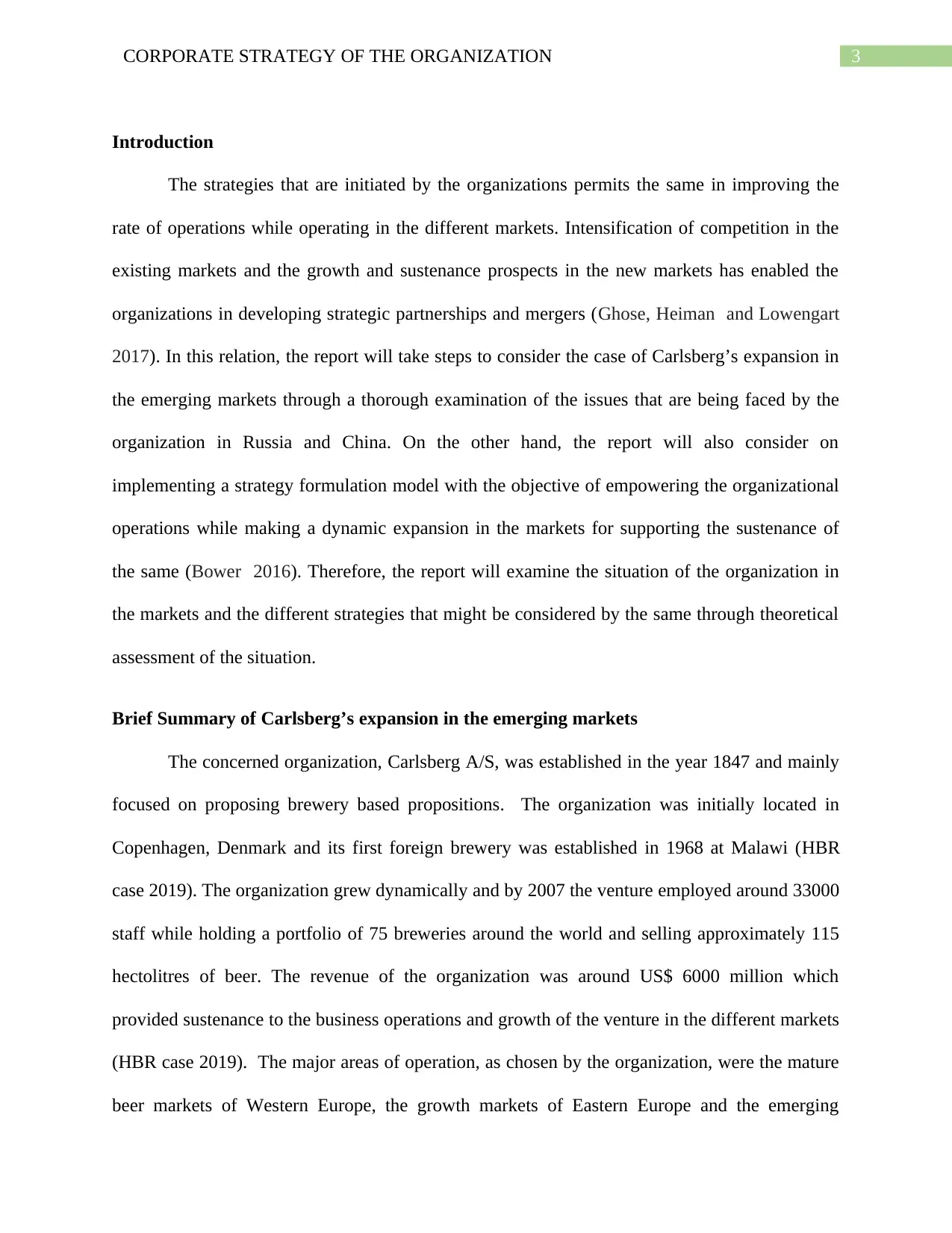
3CORPORATE STRATEGY OF THE ORGANIZATION
Introduction
The strategies that are initiated by the organizations permits the same in improving the
rate of operations while operating in the different markets. Intensification of competition in the
existing markets and the growth and sustenance prospects in the new markets has enabled the
organizations in developing strategic partnerships and mergers (Ghose, Heiman and Lowengart
2017). In this relation, the report will take steps to consider the case of Carlsberg’s expansion in
the emerging markets through a thorough examination of the issues that are being faced by the
organization in Russia and China. On the other hand, the report will also consider on
implementing a strategy formulation model with the objective of empowering the organizational
operations while making a dynamic expansion in the markets for supporting the sustenance of
the same (Bower 2016). Therefore, the report will examine the situation of the organization in
the markets and the different strategies that might be considered by the same through theoretical
assessment of the situation.
Brief Summary of Carlsberg’s expansion in the emerging markets
The concerned organization, Carlsberg A/S, was established in the year 1847 and mainly
focused on proposing brewery based propositions. The organization was initially located in
Copenhagen, Denmark and its first foreign brewery was established in 1968 at Malawi (HBR
case 2019). The organization grew dynamically and by 2007 the venture employed around 33000
staff while holding a portfolio of 75 breweries around the world and selling approximately 115
hectolitres of beer. The revenue of the organization was around US$ 6000 million which
provided sustenance to the business operations and growth of the venture in the different markets
(HBR case 2019). The major areas of operation, as chosen by the organization, were the mature
beer markets of Western Europe, the growth markets of Eastern Europe and the emerging
Introduction
The strategies that are initiated by the organizations permits the same in improving the
rate of operations while operating in the different markets. Intensification of competition in the
existing markets and the growth and sustenance prospects in the new markets has enabled the
organizations in developing strategic partnerships and mergers (Ghose, Heiman and Lowengart
2017). In this relation, the report will take steps to consider the case of Carlsberg’s expansion in
the emerging markets through a thorough examination of the issues that are being faced by the
organization in Russia and China. On the other hand, the report will also consider on
implementing a strategy formulation model with the objective of empowering the organizational
operations while making a dynamic expansion in the markets for supporting the sustenance of
the same (Bower 2016). Therefore, the report will examine the situation of the organization in
the markets and the different strategies that might be considered by the same through theoretical
assessment of the situation.
Brief Summary of Carlsberg’s expansion in the emerging markets
The concerned organization, Carlsberg A/S, was established in the year 1847 and mainly
focused on proposing brewery based propositions. The organization was initially located in
Copenhagen, Denmark and its first foreign brewery was established in 1968 at Malawi (HBR
case 2019). The organization grew dynamically and by 2007 the venture employed around 33000
staff while holding a portfolio of 75 breweries around the world and selling approximately 115
hectolitres of beer. The revenue of the organization was around US$ 6000 million which
provided sustenance to the business operations and growth of the venture in the different markets
(HBR case 2019). The major areas of operation, as chosen by the organization, were the mature
beer markets of Western Europe, the growth markets of Eastern Europe and the emerging
Paraphrase This Document
Need a fresh take? Get an instant paraphrase of this document with our AI Paraphraser
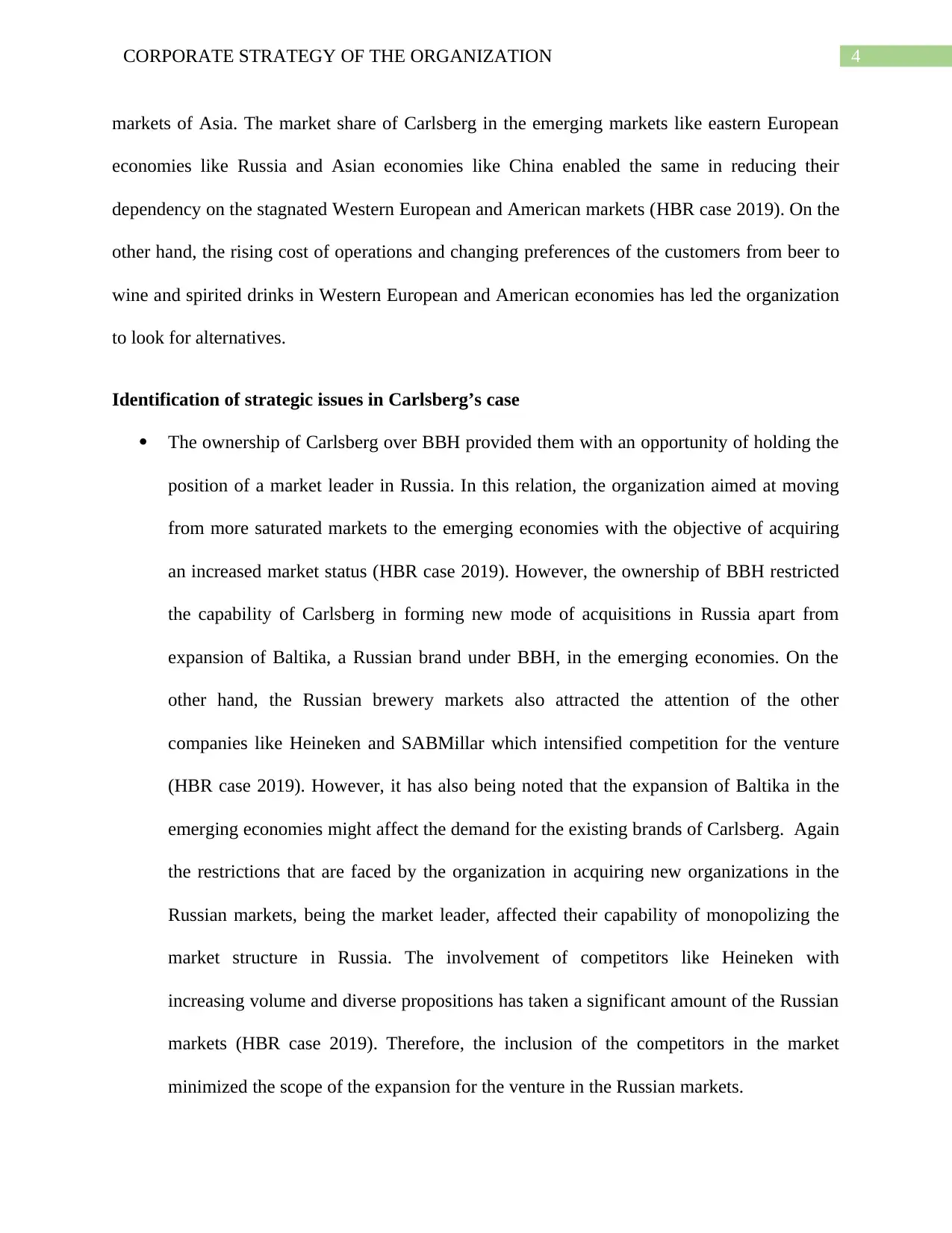
4CORPORATE STRATEGY OF THE ORGANIZATION
markets of Asia. The market share of Carlsberg in the emerging markets like eastern European
economies like Russia and Asian economies like China enabled the same in reducing their
dependency on the stagnated Western European and American markets (HBR case 2019). On the
other hand, the rising cost of operations and changing preferences of the customers from beer to
wine and spirited drinks in Western European and American economies has led the organization
to look for alternatives.
Identification of strategic issues in Carlsberg’s case
The ownership of Carlsberg over BBH provided them with an opportunity of holding the
position of a market leader in Russia. In this relation, the organization aimed at moving
from more saturated markets to the emerging economies with the objective of acquiring
an increased market status (HBR case 2019). However, the ownership of BBH restricted
the capability of Carlsberg in forming new mode of acquisitions in Russia apart from
expansion of Baltika, a Russian brand under BBH, in the emerging economies. On the
other hand, the Russian brewery markets also attracted the attention of the other
companies like Heineken and SABMillar which intensified competition for the venture
(HBR case 2019). However, it has also being noted that the expansion of Baltika in the
emerging economies might affect the demand for the existing brands of Carlsberg. Again
the restrictions that are faced by the organization in acquiring new organizations in the
Russian markets, being the market leader, affected their capability of monopolizing the
market structure in Russia. The involvement of competitors like Heineken with
increasing volume and diverse propositions has taken a significant amount of the Russian
markets (HBR case 2019). Therefore, the inclusion of the competitors in the market
minimized the scope of the expansion for the venture in the Russian markets.
markets of Asia. The market share of Carlsberg in the emerging markets like eastern European
economies like Russia and Asian economies like China enabled the same in reducing their
dependency on the stagnated Western European and American markets (HBR case 2019). On the
other hand, the rising cost of operations and changing preferences of the customers from beer to
wine and spirited drinks in Western European and American economies has led the organization
to look for alternatives.
Identification of strategic issues in Carlsberg’s case
The ownership of Carlsberg over BBH provided them with an opportunity of holding the
position of a market leader in Russia. In this relation, the organization aimed at moving
from more saturated markets to the emerging economies with the objective of acquiring
an increased market status (HBR case 2019). However, the ownership of BBH restricted
the capability of Carlsberg in forming new mode of acquisitions in Russia apart from
expansion of Baltika, a Russian brand under BBH, in the emerging economies. On the
other hand, the Russian brewery markets also attracted the attention of the other
companies like Heineken and SABMillar which intensified competition for the venture
(HBR case 2019). However, it has also being noted that the expansion of Baltika in the
emerging economies might affect the demand for the existing brands of Carlsberg. Again
the restrictions that are faced by the organization in acquiring new organizations in the
Russian markets, being the market leader, affected their capability of monopolizing the
market structure in Russia. The involvement of competitors like Heineken with
increasing volume and diverse propositions has taken a significant amount of the Russian
markets (HBR case 2019). Therefore, the inclusion of the competitors in the market
minimized the scope of the expansion for the venture in the Russian markets.
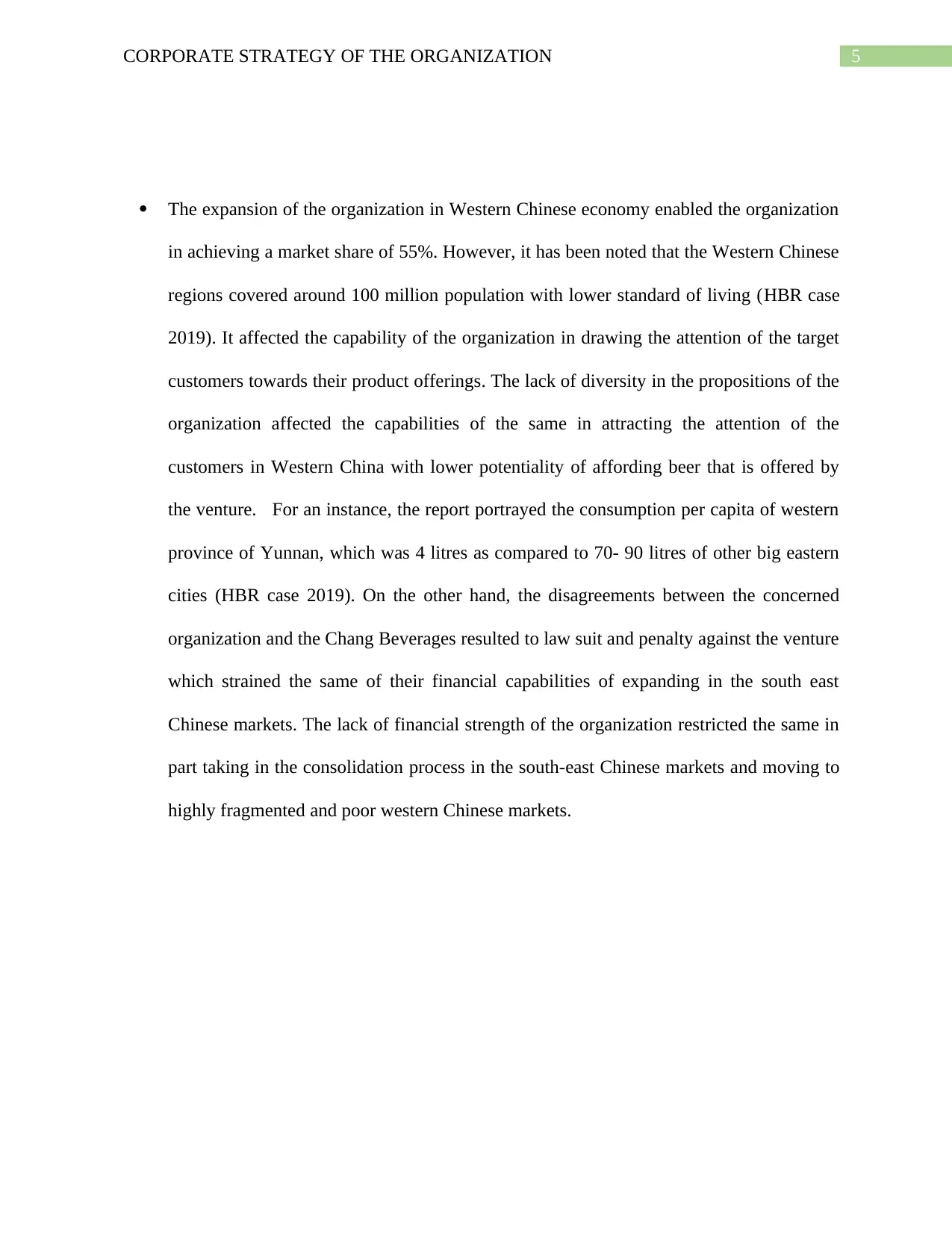
5CORPORATE STRATEGY OF THE ORGANIZATION
The expansion of the organization in Western Chinese economy enabled the organization
in achieving a market share of 55%. However, it has been noted that the Western Chinese
regions covered around 100 million population with lower standard of living (HBR case
2019). It affected the capability of the organization in drawing the attention of the target
customers towards their product offerings. The lack of diversity in the propositions of the
organization affected the capabilities of the same in attracting the attention of the
customers in Western China with lower potentiality of affording beer that is offered by
the venture. For an instance, the report portrayed the consumption per capita of western
province of Yunnan, which was 4 litres as compared to 70- 90 litres of other big eastern
cities (HBR case 2019). On the other hand, the disagreements between the concerned
organization and the Chang Beverages resulted to law suit and penalty against the venture
which strained the same of their financial capabilities of expanding in the south east
Chinese markets. The lack of financial strength of the organization restricted the same in
part taking in the consolidation process in the south-east Chinese markets and moving to
highly fragmented and poor western Chinese markets.
The expansion of the organization in Western Chinese economy enabled the organization
in achieving a market share of 55%. However, it has been noted that the Western Chinese
regions covered around 100 million population with lower standard of living (HBR case
2019). It affected the capability of the organization in drawing the attention of the target
customers towards their product offerings. The lack of diversity in the propositions of the
organization affected the capabilities of the same in attracting the attention of the
customers in Western China with lower potentiality of affording beer that is offered by
the venture. For an instance, the report portrayed the consumption per capita of western
province of Yunnan, which was 4 litres as compared to 70- 90 litres of other big eastern
cities (HBR case 2019). On the other hand, the disagreements between the concerned
organization and the Chang Beverages resulted to law suit and penalty against the venture
which strained the same of their financial capabilities of expanding in the south east
Chinese markets. The lack of financial strength of the organization restricted the same in
part taking in the consolidation process in the south-east Chinese markets and moving to
highly fragmented and poor western Chinese markets.
⊘ This is a preview!⊘
Do you want full access?
Subscribe today to unlock all pages.

Trusted by 1+ million students worldwide
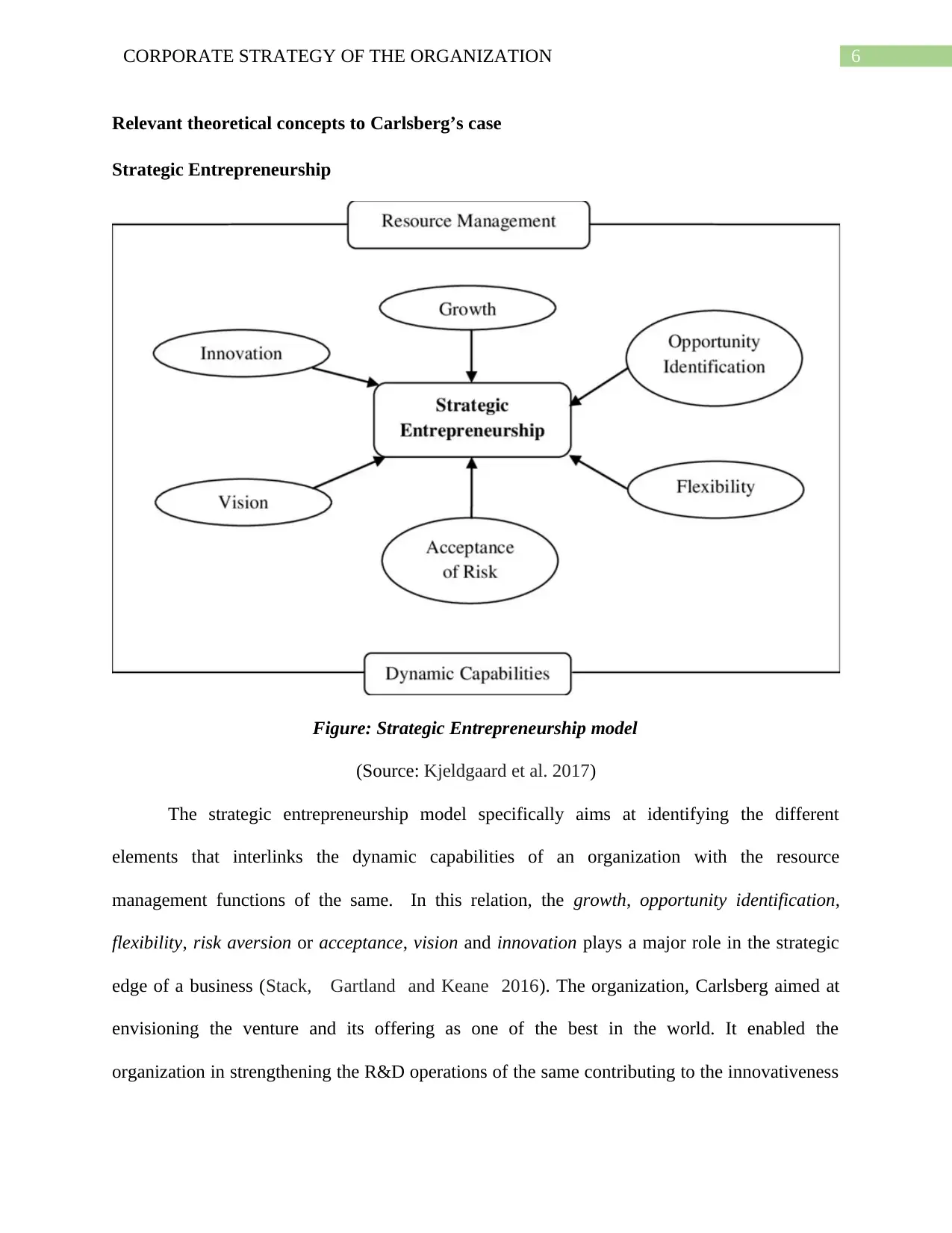
6CORPORATE STRATEGY OF THE ORGANIZATION
Relevant theoretical concepts to Carlsberg’s case
Strategic Entrepreneurship
Figure: Strategic Entrepreneurship model
(Source: Kjeldgaard et al. 2017)
The strategic entrepreneurship model specifically aims at identifying the different
elements that interlinks the dynamic capabilities of an organization with the resource
management functions of the same. In this relation, the growth, opportunity identification,
flexibility, risk aversion or acceptance, vision and innovation plays a major role in the strategic
edge of a business (Stack, Gartland and Keane 2016). The organization, Carlsberg aimed at
envisioning the venture and its offering as one of the best in the world. It enabled the
organization in strengthening the R&D operations of the same contributing to the innovativeness
Relevant theoretical concepts to Carlsberg’s case
Strategic Entrepreneurship
Figure: Strategic Entrepreneurship model
(Source: Kjeldgaard et al. 2017)
The strategic entrepreneurship model specifically aims at identifying the different
elements that interlinks the dynamic capabilities of an organization with the resource
management functions of the same. In this relation, the growth, opportunity identification,
flexibility, risk aversion or acceptance, vision and innovation plays a major role in the strategic
edge of a business (Stack, Gartland and Keane 2016). The organization, Carlsberg aimed at
envisioning the venture and its offering as one of the best in the world. It enabled the
organization in strengthening the R&D operations of the same contributing to the innovativeness
Paraphrase This Document
Need a fresh take? Get an instant paraphrase of this document with our AI Paraphraser
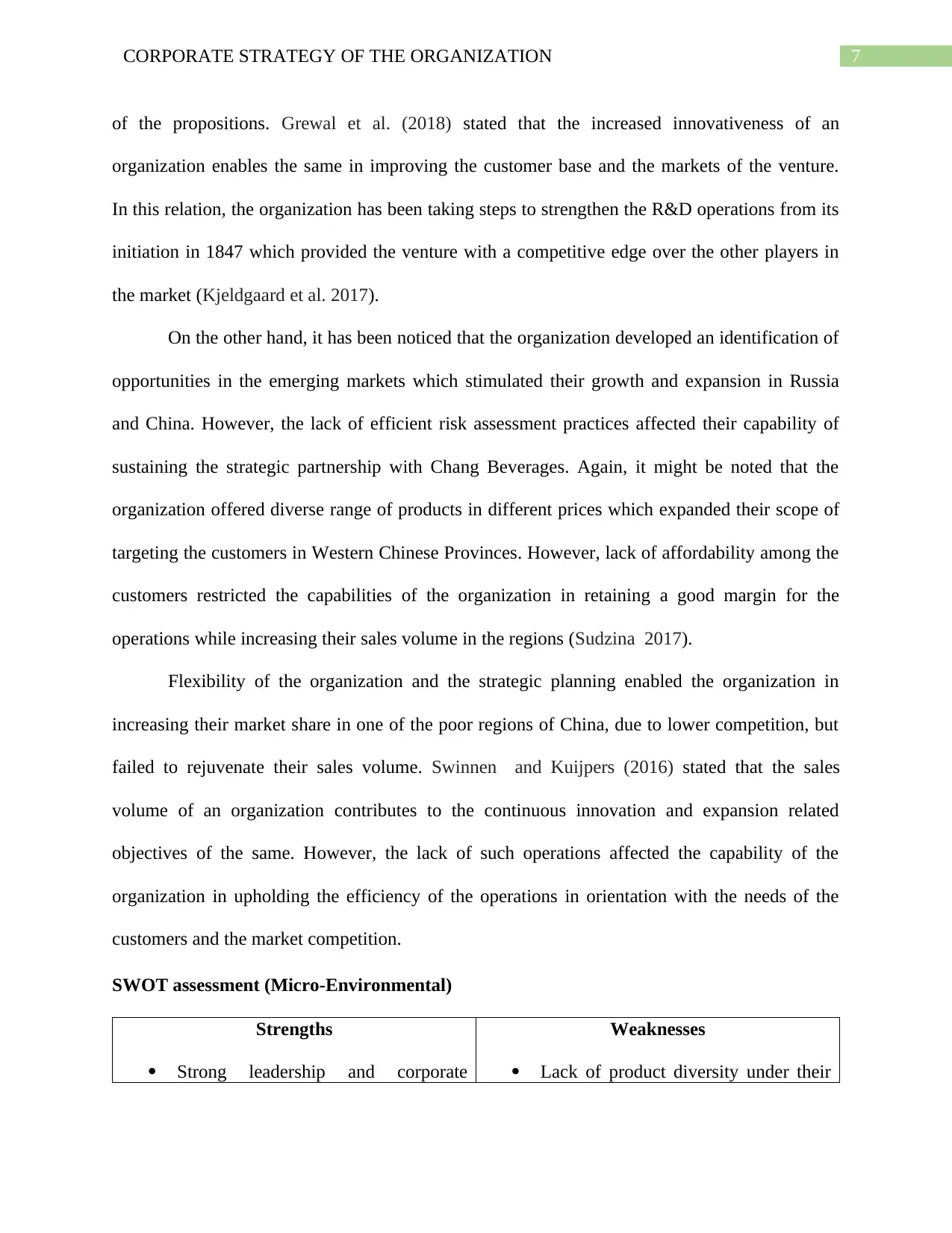
7CORPORATE STRATEGY OF THE ORGANIZATION
of the propositions. Grewal et al. (2018) stated that the increased innovativeness of an
organization enables the same in improving the customer base and the markets of the venture.
In this relation, the organization has been taking steps to strengthen the R&D operations from its
initiation in 1847 which provided the venture with a competitive edge over the other players in
the market (Kjeldgaard et al. 2017).
On the other hand, it has been noticed that the organization developed an identification of
opportunities in the emerging markets which stimulated their growth and expansion in Russia
and China. However, the lack of efficient risk assessment practices affected their capability of
sustaining the strategic partnership with Chang Beverages. Again, it might be noted that the
organization offered diverse range of products in different prices which expanded their scope of
targeting the customers in Western Chinese Provinces. However, lack of affordability among the
customers restricted the capabilities of the organization in retaining a good margin for the
operations while increasing their sales volume in the regions (Sudzina 2017).
Flexibility of the organization and the strategic planning enabled the organization in
increasing their market share in one of the poor regions of China, due to lower competition, but
failed to rejuvenate their sales volume. Swinnen and Kuijpers (2016) stated that the sales
volume of an organization contributes to the continuous innovation and expansion related
objectives of the same. However, the lack of such operations affected the capability of the
organization in upholding the efficiency of the operations in orientation with the needs of the
customers and the market competition.
SWOT assessment (Micro-Environmental)
Strengths
Strong leadership and corporate
Weaknesses
Lack of product diversity under their
of the propositions. Grewal et al. (2018) stated that the increased innovativeness of an
organization enables the same in improving the customer base and the markets of the venture.
In this relation, the organization has been taking steps to strengthen the R&D operations from its
initiation in 1847 which provided the venture with a competitive edge over the other players in
the market (Kjeldgaard et al. 2017).
On the other hand, it has been noticed that the organization developed an identification of
opportunities in the emerging markets which stimulated their growth and expansion in Russia
and China. However, the lack of efficient risk assessment practices affected their capability of
sustaining the strategic partnership with Chang Beverages. Again, it might be noted that the
organization offered diverse range of products in different prices which expanded their scope of
targeting the customers in Western Chinese Provinces. However, lack of affordability among the
customers restricted the capabilities of the organization in retaining a good margin for the
operations while increasing their sales volume in the regions (Sudzina 2017).
Flexibility of the organization and the strategic planning enabled the organization in
increasing their market share in one of the poor regions of China, due to lower competition, but
failed to rejuvenate their sales volume. Swinnen and Kuijpers (2016) stated that the sales
volume of an organization contributes to the continuous innovation and expansion related
objectives of the same. However, the lack of such operations affected the capability of the
organization in upholding the efficiency of the operations in orientation with the needs of the
customers and the market competition.
SWOT assessment (Micro-Environmental)
Strengths
Strong leadership and corporate
Weaknesses
Lack of product diversity under their
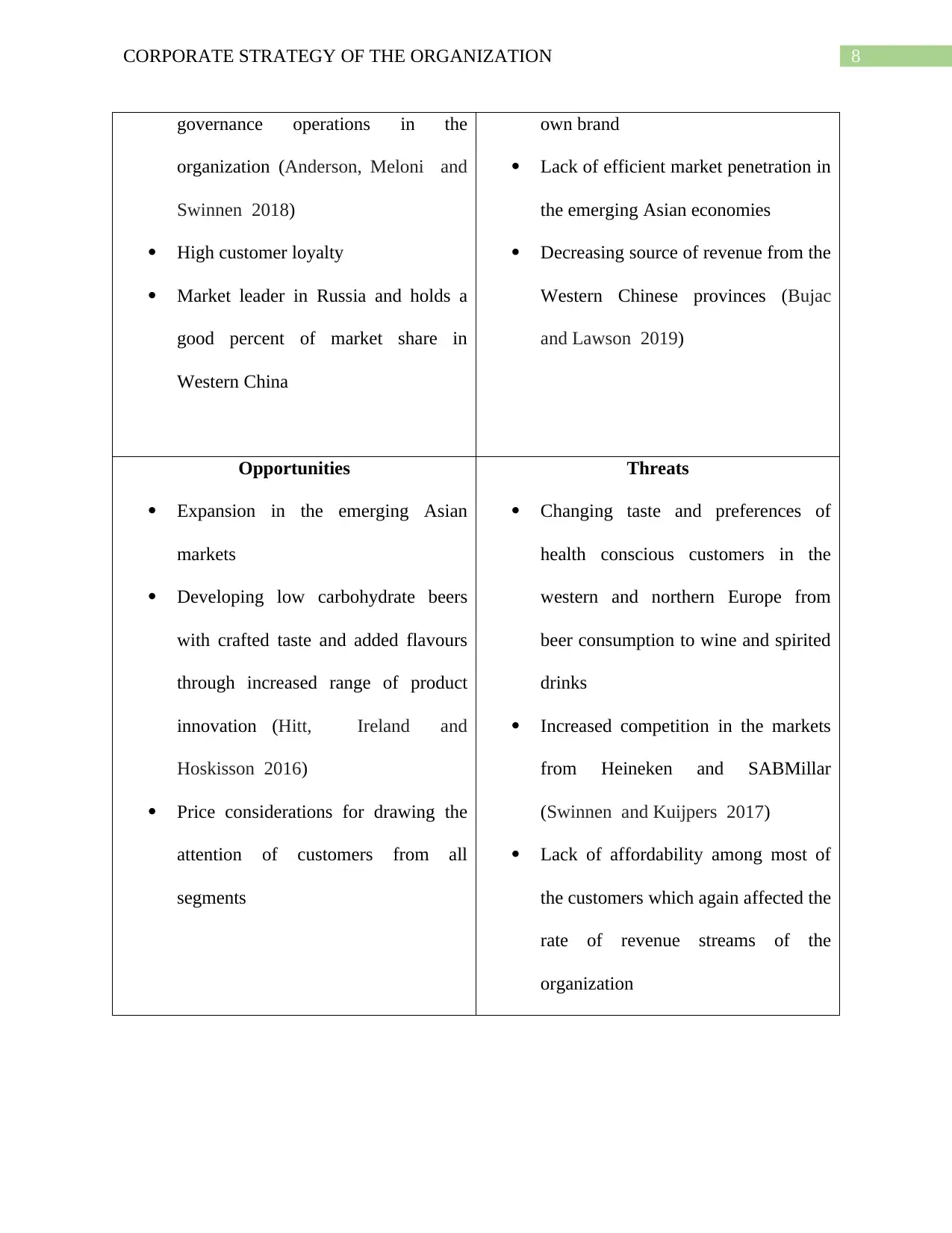
8CORPORATE STRATEGY OF THE ORGANIZATION
governance operations in the
organization (Anderson, Meloni and
Swinnen 2018)
High customer loyalty
Market leader in Russia and holds a
good percent of market share in
Western China
own brand
Lack of efficient market penetration in
the emerging Asian economies
Decreasing source of revenue from the
Western Chinese provinces (Bujac
and Lawson 2019)
Opportunities
Expansion in the emerging Asian
markets
Developing low carbohydrate beers
with crafted taste and added flavours
through increased range of product
innovation (Hitt, Ireland and
Hoskisson 2016)
Price considerations for drawing the
attention of customers from all
segments
Threats
Changing taste and preferences of
health conscious customers in the
western and northern Europe from
beer consumption to wine and spirited
drinks
Increased competition in the markets
from Heineken and SABMillar
(Swinnen and Kuijpers 2017)
Lack of affordability among most of
the customers which again affected the
rate of revenue streams of the
organization
governance operations in the
organization (Anderson, Meloni and
Swinnen 2018)
High customer loyalty
Market leader in Russia and holds a
good percent of market share in
Western China
own brand
Lack of efficient market penetration in
the emerging Asian economies
Decreasing source of revenue from the
Western Chinese provinces (Bujac
and Lawson 2019)
Opportunities
Expansion in the emerging Asian
markets
Developing low carbohydrate beers
with crafted taste and added flavours
through increased range of product
innovation (Hitt, Ireland and
Hoskisson 2016)
Price considerations for drawing the
attention of customers from all
segments
Threats
Changing taste and preferences of
health conscious customers in the
western and northern Europe from
beer consumption to wine and spirited
drinks
Increased competition in the markets
from Heineken and SABMillar
(Swinnen and Kuijpers 2017)
Lack of affordability among most of
the customers which again affected the
rate of revenue streams of the
organization
⊘ This is a preview!⊘
Do you want full access?
Subscribe today to unlock all pages.

Trusted by 1+ million students worldwide
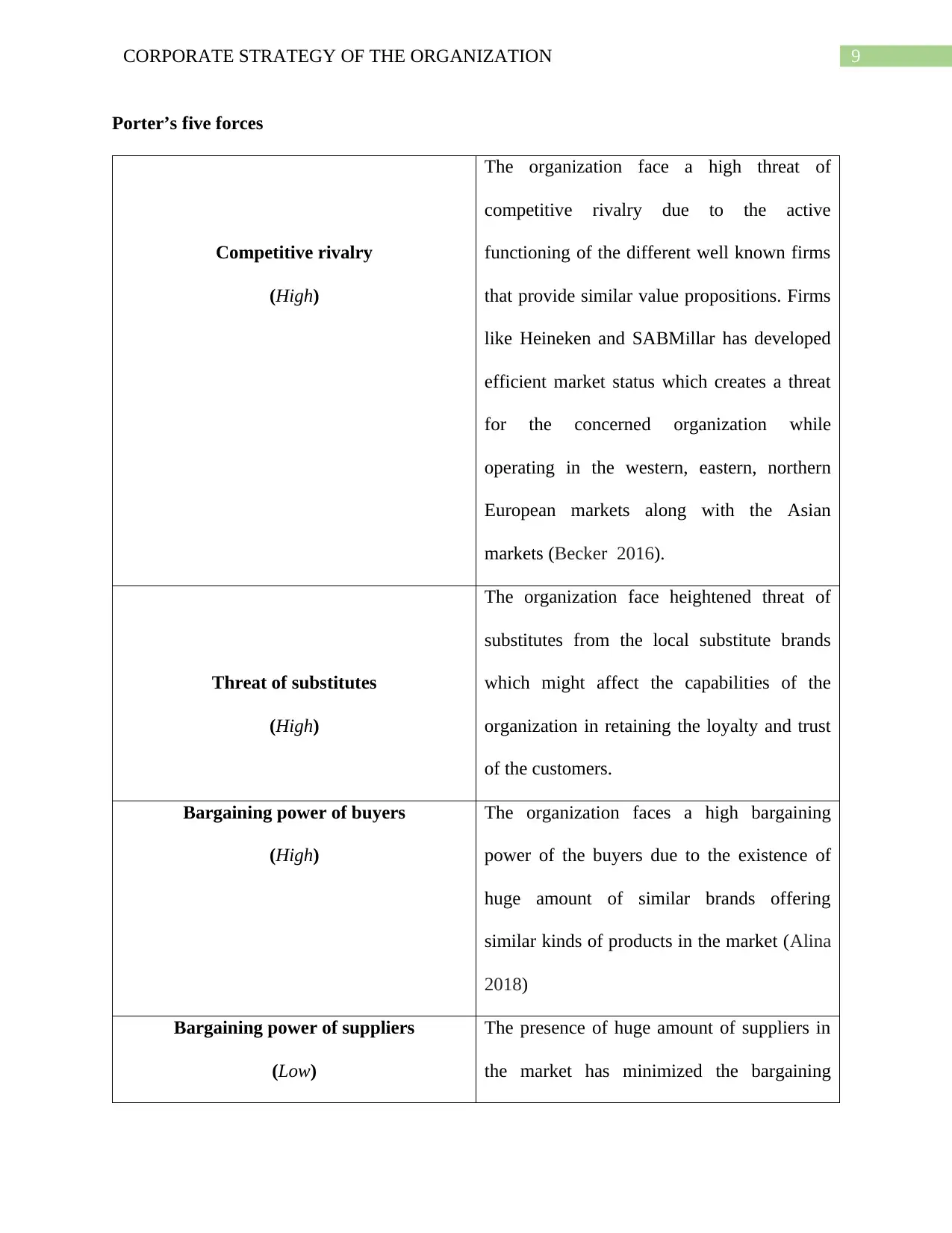
9CORPORATE STRATEGY OF THE ORGANIZATION
Porter’s five forces
Competitive rivalry
(High)
The organization face a high threat of
competitive rivalry due to the active
functioning of the different well known firms
that provide similar value propositions. Firms
like Heineken and SABMillar has developed
efficient market status which creates a threat
for the concerned organization while
operating in the western, eastern, northern
European markets along with the Asian
markets (Becker 2016).
Threat of substitutes
(High)
The organization face heightened threat of
substitutes from the local substitute brands
which might affect the capabilities of the
organization in retaining the loyalty and trust
of the customers.
Bargaining power of buyers
(High)
The organization faces a high bargaining
power of the buyers due to the existence of
huge amount of similar brands offering
similar kinds of products in the market (Alina
2018)
Bargaining power of suppliers
(Low)
The presence of huge amount of suppliers in
the market has minimized the bargaining
Porter’s five forces
Competitive rivalry
(High)
The organization face a high threat of
competitive rivalry due to the active
functioning of the different well known firms
that provide similar value propositions. Firms
like Heineken and SABMillar has developed
efficient market status which creates a threat
for the concerned organization while
operating in the western, eastern, northern
European markets along with the Asian
markets (Becker 2016).
Threat of substitutes
(High)
The organization face heightened threat of
substitutes from the local substitute brands
which might affect the capabilities of the
organization in retaining the loyalty and trust
of the customers.
Bargaining power of buyers
(High)
The organization faces a high bargaining
power of the buyers due to the existence of
huge amount of similar brands offering
similar kinds of products in the market (Alina
2018)
Bargaining power of suppliers
(Low)
The presence of huge amount of suppliers in
the market has minimized the bargaining
Paraphrase This Document
Need a fresh take? Get an instant paraphrase of this document with our AI Paraphraser
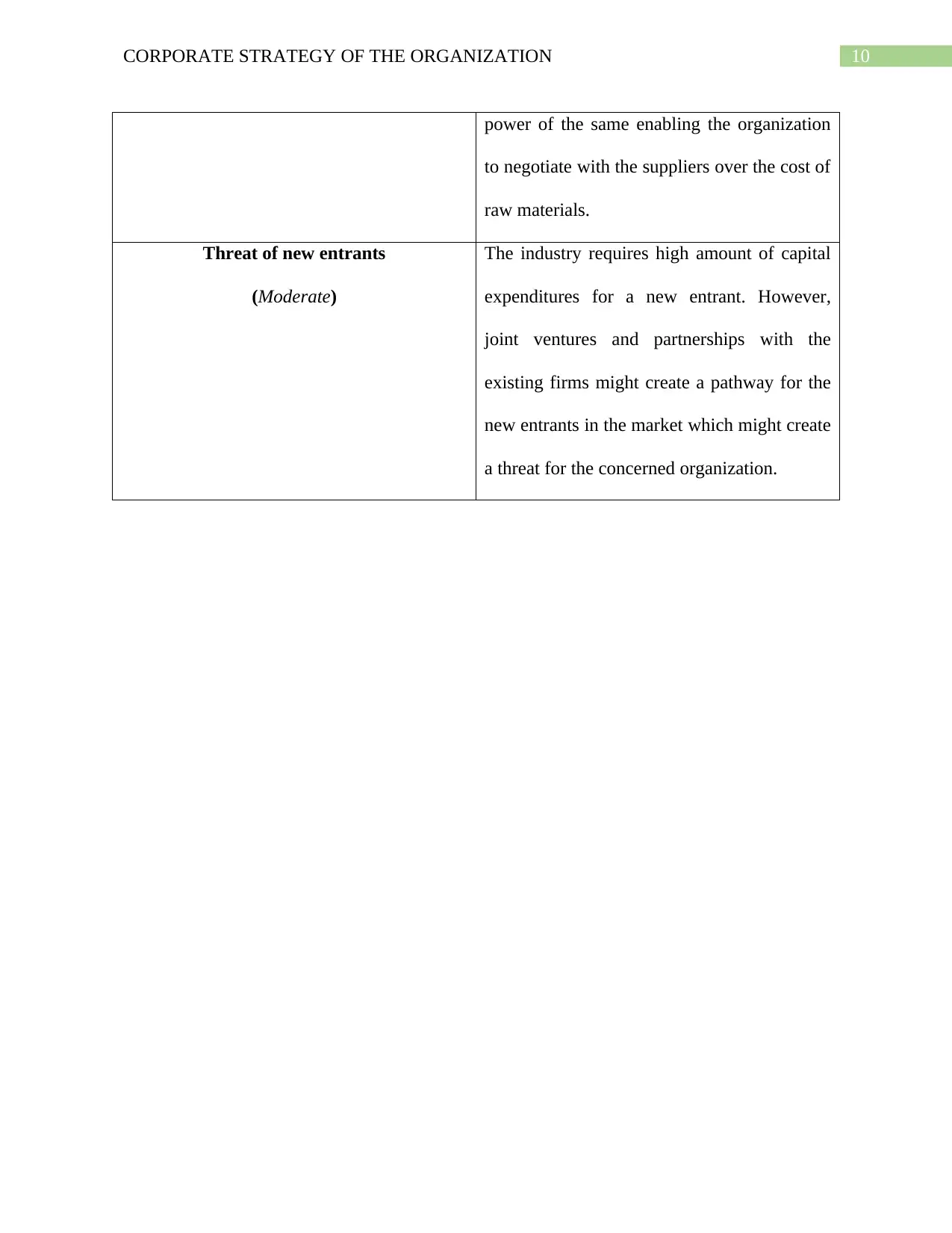
10CORPORATE STRATEGY OF THE ORGANIZATION
power of the same enabling the organization
to negotiate with the suppliers over the cost of
raw materials.
Threat of new entrants
(Moderate)
The industry requires high amount of capital
expenditures for a new entrant. However,
joint ventures and partnerships with the
existing firms might create a pathway for the
new entrants in the market which might create
a threat for the concerned organization.
power of the same enabling the organization
to negotiate with the suppliers over the cost of
raw materials.
Threat of new entrants
(Moderate)
The industry requires high amount of capital
expenditures for a new entrant. However,
joint ventures and partnerships with the
existing firms might create a pathway for the
new entrants in the market which might create
a threat for the concerned organization.
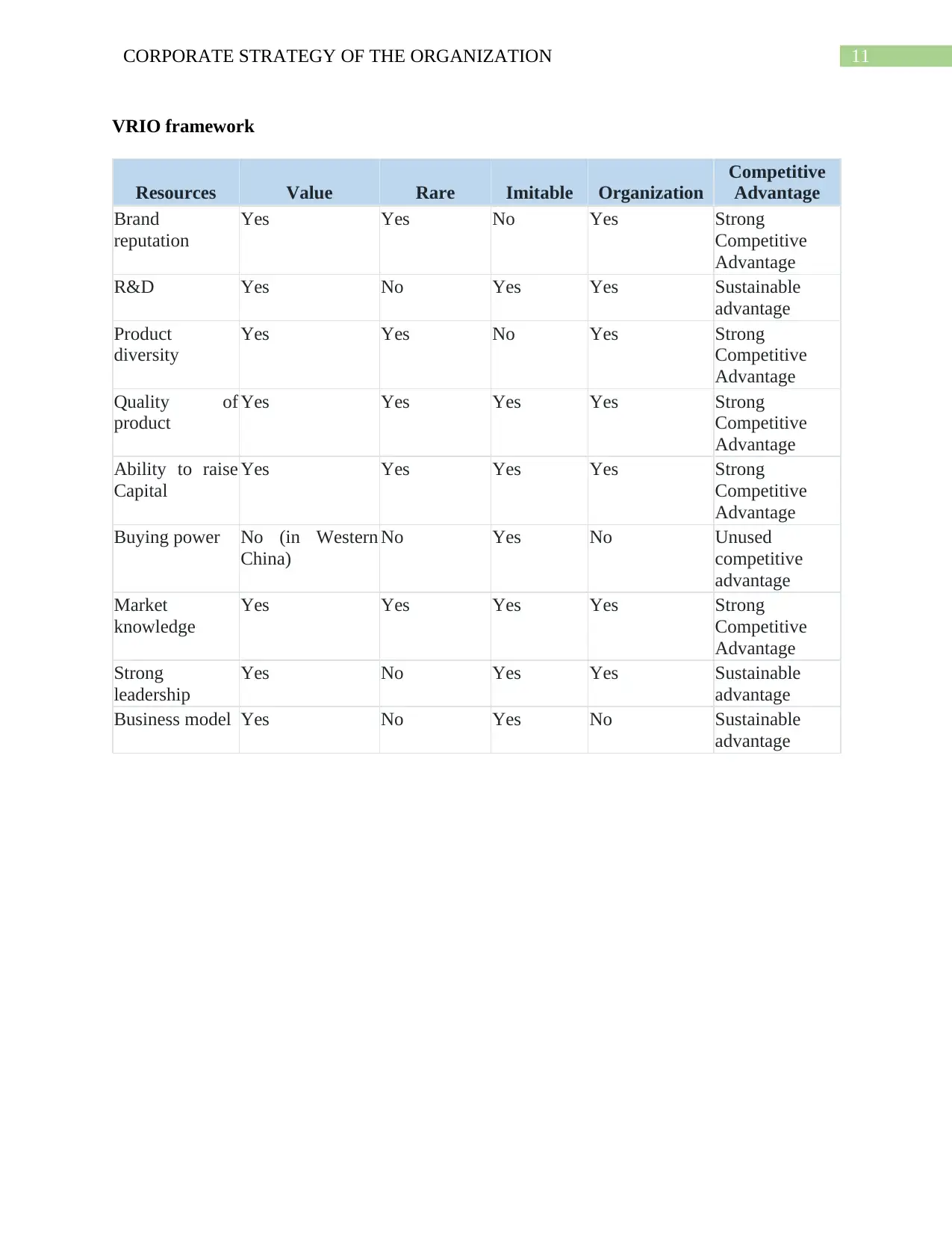
11CORPORATE STRATEGY OF THE ORGANIZATION
VRIO framework
Resources Value Rare Imitable Organization
Competitive
Advantage
Brand
reputation
Yes Yes No Yes Strong
Competitive
Advantage
R&D Yes No Yes Yes Sustainable
advantage
Product
diversity
Yes Yes No Yes Strong
Competitive
Advantage
Quality of
product
Yes Yes Yes Yes Strong
Competitive
Advantage
Ability to raise
Capital
Yes Yes Yes Yes Strong
Competitive
Advantage
Buying power No (in Western
China)
No Yes No Unused
competitive
advantage
Market
knowledge
Yes Yes Yes Yes Strong
Competitive
Advantage
Strong
leadership
Yes No Yes Yes Sustainable
advantage
Business model Yes No Yes No Sustainable
advantage
VRIO framework
Resources Value Rare Imitable Organization
Competitive
Advantage
Brand
reputation
Yes Yes No Yes Strong
Competitive
Advantage
R&D Yes No Yes Yes Sustainable
advantage
Product
diversity
Yes Yes No Yes Strong
Competitive
Advantage
Quality of
product
Yes Yes Yes Yes Strong
Competitive
Advantage
Ability to raise
Capital
Yes Yes Yes Yes Strong
Competitive
Advantage
Buying power No (in Western
China)
No Yes No Unused
competitive
advantage
Market
knowledge
Yes Yes Yes Yes Strong
Competitive
Advantage
Strong
leadership
Yes No Yes Yes Sustainable
advantage
Business model Yes No Yes No Sustainable
advantage
⊘ This is a preview!⊘
Do you want full access?
Subscribe today to unlock all pages.

Trusted by 1+ million students worldwide
1 out of 17
Related Documents
Your All-in-One AI-Powered Toolkit for Academic Success.
+13062052269
info@desklib.com
Available 24*7 on WhatsApp / Email
![[object Object]](/_next/static/media/star-bottom.7253800d.svg)
Unlock your academic potential
Copyright © 2020–2025 A2Z Services. All Rights Reserved. Developed and managed by ZUCOL.





